Sampling pump
Beforehand on sampling sometimes water needs to be removed and to sample also the water needs to be extracted from the subsoil. Various kinds of pumping systems are used for these operations, some are explained and listed below.
By pushing water upwards
Bellow pump (gas pressure system)
Depending on the depth, the maximum flow rate varies between 2.5 and 4 l/min. The maximum sampling depth is approx. 60 m. Inline filtration and the required measurements can also be carried out. The pump operates on air pressure, without the air coming into contact with the water sample. This is ensured by a Teflon bellows mounted in the pump housing. It is a pulsating pump. In a first stage, the water is drawn in by contraction of the bellows. During the second stage, the water is forced upwards by expansion of the bellows. The bellows pump is equipped with the necessary check valves so that no backflow can occur. However, care should be taken for cross-contamination as one always works with the same hoses. Since certain parts of the (difficult to clean) pump housing come into contact with the groundwater from different monitoring wells, cross-contamination may occur. The use of this type of pump is not allowed for the sampling itself. This pump is usually used for pumping clean after well placement.
Double valve pump
The double valve pump is a pneumatically driven pump that can be used at low to medium flow rates, and depending on the type, can be used at considerable depths (150 m). Compared to the bellows pump, this type of pump offers the advantage that higher flow rates can be achieved and no bellows replacement is required.
Deepwell pump
A pump designed for pumping water from wells with water levels more than about seven meters below the pump location. Such pumps are designed so that the pump cylinder is near the well water level and the water is forced to the surface rather than being sucked to it.
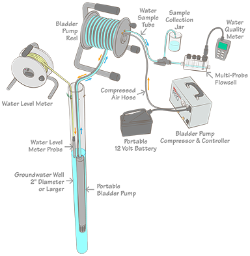
Handpump
This is a pump operated by hand, can be any type of pump.
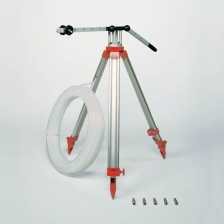
Ball valve pump
When pumping systems are part of very long piping systems, pump control valves are necessary to control water hammer or pressure surges. Pump control valves are typically quarter‐turn valves equipped with slow opening and closing electric motor or hydraulic cylinder actuators. The actuator is powered by an external electric or pressure source and must be electrically connected to the pump circuit for control purposes. The motion of the closure member in these valves is controlled by the power actuator so they are not subject to fluttering or slamming like automatic check valves. Battery systems or pressurized accumulator systems can be used to enable the pump control valve to close after a power failure.
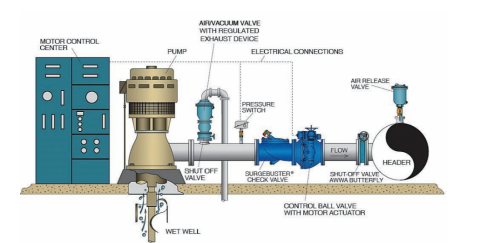
Submersible pump (underwater centrifugal pump)
The submersible pump or impeller pump is a centrifugal pump used underwater; this pump is usually made of stainless steel and Teflon. This type of pump is very well suited to both clean pumping and groundwater sampling from deep wells because of the following characteristics:
- the flow rate is finely adjustable;
- the abstraction flow rate is characterized by a wide range: both low and high abstraction flow rates can be set;
- Due to specific internal construction, the submersible pump causes little turbulence, in contrast to the above-ground centrifugal pump;
- does not suck in air;
- groundwater is drawn in at the bottom of the pump.
The diameter of the monitoring well that can be sampled depends on the type of submersible pump. MP1 pumps, for instance, can only be used for monitoring wells or sumps with an internal diameter of at least 50 mm.
Since the pump is suspended in the groundwater sufficient attention must be paid to the occurrence of cross contamination. Therefore the pump and the suction tube should be rinsed with pure water of drinking quality after each use. In addition, at the end of each sampling day, a cleaning with hot water and detergent should be performed (followed by extensive rinsing). Regular flushing can also significantly extend the life of the pump. The delivery hoses should be replaced if they visually show contamination (deposits), but at least once a year. If the pump has been in contact with pure product, it should be thoroughly cleaned before further use in clean-rinsing and/or pre-pumping and sampling.
12V submersible pumps (DC pumps)
The 12V submersible pumps are a cheaper, low power version (5 to 10 m pressure head) of the underwater centrifugal pump. They are made of a non-inert plastic, and therefore intended for single use for sampling. They can be coupled together until a total head of up to about 36 m is achieved. However, the reasonable flow rate they achieve makes them well suited for pumping monitoring wells clean after placement. If used once, they can be applied for pre-pumping and sampling of groundwater. Usually DC pumps are used in combination with the electronic peristaltic pump. Exceptionally, multiple use can be allowed for background determination and if the level of contamination is known (condition no organic contamination)
By the suction of water
Peristaltic pump
A peristaltic pump, also commonly known as a roller pump, is a type of positive displacement pump used for pumping a variety of fluids. The fluid is contained in a flexible tube fitted inside a circular pump casing. Most peristaltic pumps work through rotary motion, though linear peristaltic pumps have also been made. The rotor has a number of "wipers" or "rollers" attached to its external circumference, which compress the flexible tube as they rotate by. The part of the tube under compression is closed, forcing the fluid to move through the tube. Additionally, as the tube opens to its natural state after the rollers pass, more fluid is drawn into the tube. This process is called peristalsis and is used in many biological systems such as the gastrointestinal tract. Typically, there will be two or more rollers compressing the tube, trapping a body of fluid between them. The body of fluid is transported through the tube, toward the pump outlet. Peristaltic pumps may run continuously, or they may be indexed through partial revolutions to deliver smaller amounts of fluid. [1]
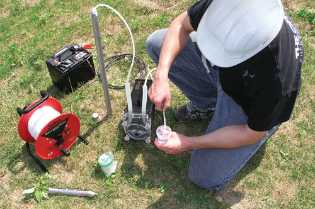
Working principle
The operation of a peristaltic pump is based on pipe pressing. The blackmail operation of the pipeline is done by a rotating wheel in the tube is located in the pipeline. Several pipe pressure points determine the accuracy of the pump. The elasticity of the pipeline causes its opening and produces a sub-pressure by increasing the volume that allows suction of up to approximately 0.9 bar. The actual pumping principle, called peristalsis, is based on alternating compression and relaxation of the hose or tube, drawing content in and propelling product away from the pump. Combining these suction and discharge principles results in a powerful self priming positive displacement action. Peristaltic pumps are designed for the dosing and transfer of various liquid substances, from chemicals, through sludges to ingredients and food products. [2]
Centrifugal pump (above ground)
For the "clean" pumping of monitoring wells with larger diameters, it is possible to use above-ground centrifugal pumps, driven by an internal combustion engine. These are available for pumping from pipes with diameters starting at 45 mm. The flow rate is adjustable. The high speed of the blades causes a strong turbulence, which makes sampling with regard to volatile parameters inappropriate. After removal of the pump another type of pump is used for the actual groundwater sampling. Theoretically the maximum lift for application of the centrifugal pump is 10 m, in practice this is usually limited to 6-8 m due to friction resistance.
Vacuum pump
The groundwater is sucked up by creating a negative pressure which promotes degassing. In addition, contact with air is possible so that oxidation can occur. Since the method is not suitable for measuring field parameters. The vacuum effect also occurs in all overhead pump systems as long as the suction line is not completely filled. Suction pipes should therefore always be filled completely before starting the pre-pumping (and measuring of field parameters) and sampling.
Other sampling methods
Bailer pump
The bailer pump is designed for prepumping of the subsoil. It recovers sand, gravel, gun debris or other loose fill from above or inside any subsurface flow control device.
The bailer pump operates on the fundamental lift pump and piston principle. During the upstroke of the Bailer, suction is created, drawing in debris through the Bailer Check Sub where it is retained. A ball check valve, integral to the internal rod assembly allows maximum downstroke for continuous debris recovery until the chamber is full. This method allows for limited volumes of sampling. The ball valve sampler should not be used when volatile constituents are to be analyzed
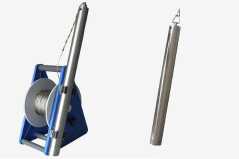
Used for
- Recovering loose sand, gravel or gun debris from inside flow control devices
- Obtaining bottom hole debris samples for analysis [3]
Liquid layer sampler
This is not a pump, but an open Teflon tube that can be sealed at the bottom. This closure is done by a closure system at the bottom of the tube that is operated by a rod or a cable. Through this system it is possible to take a sample at desired depths.